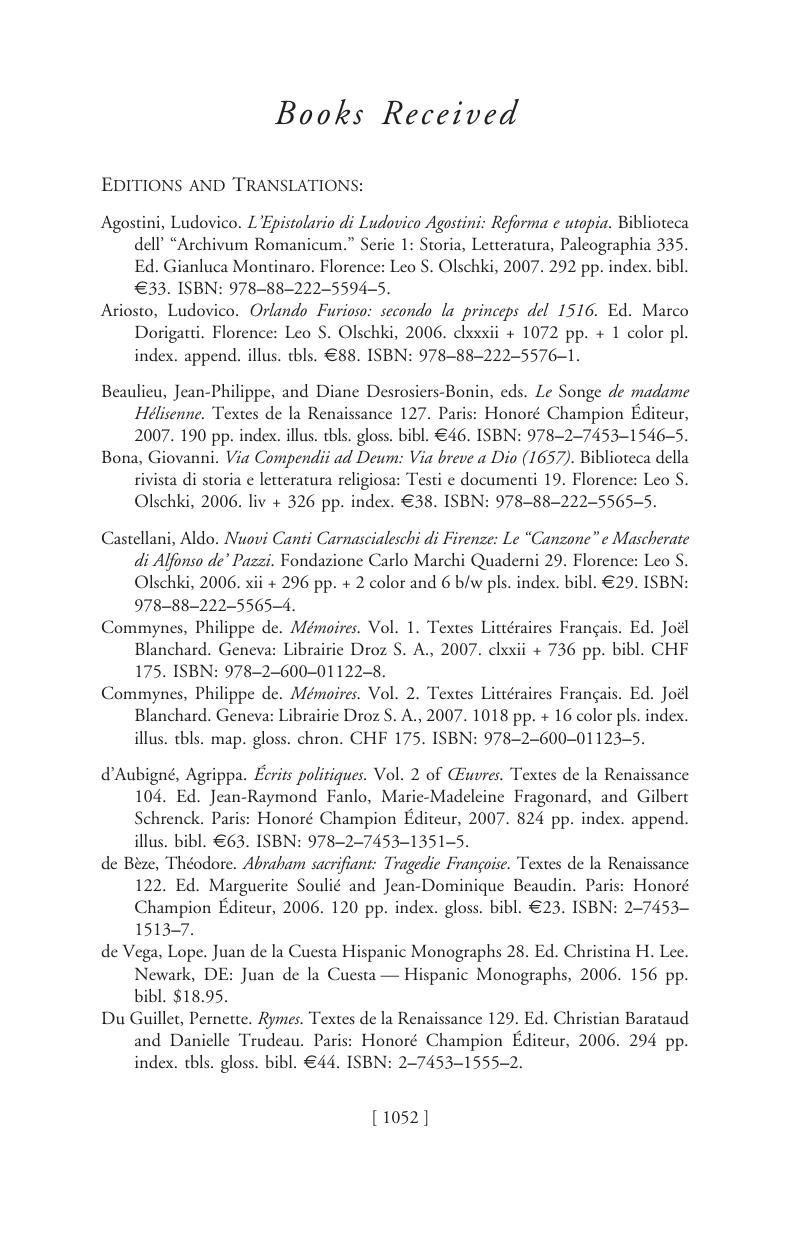Irena, Backus ed.
Théodore de Bèze (1519–1605): Actes du Colloque de Genève (septembre 2005).
Geneva :
Librairie Droz S. A.,
2007. 598 pp. index. illus. tbls. CHF 135. ISBN:
978-2-600-01118-1.
Includes: Alain Dufour, “Bèze et les grands de ce monde”; Karin Maag, “Recteur, pasteur et professeur: Théodore de Bèze et l’éducation à Genève”; Béatrice Nicollier, “Le rôle de Bèze dans le maintien et le rayonnement de l’Acad émie de Genève”; Christian Grosse, “‘Il y avoit eu trop grande rigeur par cy-devant’: la discipline ecclésiastique à Genève à l ‘é poque de Théodore de Bèze”; Christophe Chazalon, “Théodore de Bèze et les ateliers de Laon”; Jean-François Gilmont, “Théodore de Bèze et ses imprimeurs”; Daniela Solfaroli, “Celui ‘qui dans celle ville et parmi les calvinistes est comme un paper’: Genève dans la polémique religieuse autour de Bèze”; Catherine Santschi, “Théodore de Bèze et les Bernois”; Emidio Campi, “Beza und Bullinger im Lichte ihrer Korrespondenz”; Marianne Carbonnier-Burkard “L’
Histoire ecclésiastique des Eglises réformées: la construction bézienne d’un ‘corps d’histoire’”; Hervé Genton, “Histoire des reproches adressés aux
Poemata de Bèze par les polémistes luthériens”; Olivier Fatio, “Note sur les
Quaestiones et Responsiones de Bèze”; Bernard Roussel, “Le
Novum Testamentum de Théodore de Bèze: L’édition, la traduction et l’annotation de l’
É
pître de Jude”; Matteo Campagnolo, “Entre Théodore de Bèze et Erasme de Rotterdam: Isaac Casaubon”; Donald Sinnema, “Beza’s View of Predestination in Historical Perspective”; Scott M. Manetsch, “‘The most despised vocation today’: Theodore Beza’s Theology of Pastoral Ministry”; Tadataka Maruyama, “
Initia Bezae and Ecclesiology”; Peter Opitz, “Beza’s ‘Ratio docendi’: Dienerin der Theologie oder Herrscherin über die Theologie?”; Jill Raitt, “Metonymy and Relation in the Eucharistic Theology of Theodore Beza and its Reception in the 17
th Century”; Pierre Petitmengin, “De Théodore de Bèze à Jacques Godefroy: Travaux genevois sur Tertullien et Cyprien”; Irena Backus, “Quelques remarques sur les annotations doctrinales de Bèze dans son exemplaire de Tertullien”; Luka Ilic, “Beza and Flacius in the Sacramentarian Controversy”; Kirk M. Summers, “The Classical Foundations of Beza’s Thought”; Margaret Duncumb, “The Latin Psalm Paraphrases of Théodore de Bèze”; Ruth Stawarz-Luginbühl, “L’
Abraham sacrifiant, tragédie françoise ou comment mettre en scène l’épreuve de la foi?”; Charles-Antoine Chamay, “Bref retour sur la paternité des
Satyres chestiennes de la cuisine papale (1560): de nouvelles donnes en faveur de l’attribution à Théodore Bèze”; Marie-Christine Gomez-Giraud, “La rhétorique de la Bible chez Bèze et Castellion d’après leur controverse en matière de la traduction biblique”; Olivier Millet, “La rhétorique de la Bible chez Bèze et Castellion d’apr ès leur controverse en matière de la traduction biblique”; Olivier Pot, “L’invention d’un genre: Les
Chrestiennes meditations sur huict Pseaumes”; Véronique Ferrer, “Parole privée, parole pub-lique: les
Chrestiennes meditations de Théodore de Bèze”; Max Engammare, “Licence poétique
versus métrique sacrée: La polémique entre Béze et Génébrard au sujet des Psaumes et du Cantique des Cantiques (1579–86)”; Daniel Ménager, “Polémique et satire dans la
Response à la lettre d’un gentilhomme Savoysien, 1598”; Christoph Strohm, “Wirkungen der juristischen Schulung auf Bezas theolo-gisches Oeuvre”; Paul-Alexis Mellet, “Du passé au présent: les sources du
Droit des magistrats sur leurs sujets (1574)”; Béatrice Périgot, “
Du droit des magistrats de Théodore de Bèze et
Franco-Gallia de François Hotman: deux méthodes au service de la philosophie politique”; Robert M. Kingdon, “Beza’s Political Ideas as expressed in his Sermons on the Passion”; and Béatrice Nicollier, “Conclusions.”
Google Scholar 